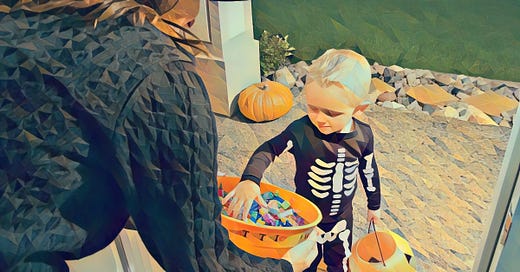Halloween is the canary in the coal mine of our civic decline
Trick-or-treating participation is a good measure of community and neighborhood trust. The 2021 numbers are bad.
If you want to measure our country’s civic health, there’s no better single day to do it than Halloween.
Ok, fine, we’ll say Election Day is first and Halloween second. Let me explain: Plenty of holidays are centered around gatherings with close friends and family. What makes Halloween unique is this odd-but-endearing tradition of costumed kids parading down sidewalks, strolling from house to decorated house for candy.
Trick-or-treating emerged in the 1930s but became incredibly commonplace by the early '50s, during the heyday of the tight-knit community and social bonds in modern America. Participating in it, either as a home dweller doling out fun-sized Snickers or as a parent or child dressed as Batman, means having some measure of social trust in neighbors or strangers.
In the sociology world, there’s a simple distinction in terms of trust between people who know each other well and with strangers. The former is based on personal experience and reputation or “thick” trust and the latter is based on beliefs and predispositions and is often called or “thin” trust.
For years, Halloween has been the canary in the coal mine signaling our decline in thin trust. As community bonds and neighborly interactions and engagement in civic institutions have declined since the 1970s, so has trick-or-treating participation.
My childhood in the ‘80s marked an inflection point in American life. I trick-or-treated every year by age three and did so without parental supervision (with brother and friends) by age six or seven. We’d knock on the doors of nearly every household on my street, I remember social pressure to take part, the people who left their porch lights off were seen as mild pariahs.
But the late ‘70s and early ‘80s was also an era of perceptible decline of thin trust due to a combination of factors, such as the two-income household, the rise of mass media that sensationalized crime, televisions in every house, automobile culture, even central air-conditioning. Everyone was increasingly out of the house to work or inside consuming media.
The most noticeable manifestation of this trend was the media-fueled moral panics about stranger danger. The ‘80s were full of urban legends about razor blades found in Hershey bars, Satan-worshipping childcare facilities, the ubiquitous mysterious man in an unmarked van luring kids in with candy. Nearly all of those tales were found to be false or highly exaggerated but they were impossible to dispel because the narrative was so attractive.
Even horror movies, I’d argue, got megapopular because they were like fictionalized narratives expressing these fears: Your neighbor down the block, the stranger from the store? He could be a serial killer. He could come for your children!
Over the last three decades, thin trust keeps slowly eroding and so does voting participation (in local and state elections especially) and—yes—trick-or-treating numbers.
In 2019, a Pew Research poll examined public life and neighborly relations and found that 71% think that interpersonal trust has declined over the past two decades, even though, until very recently, violent crime declined substantially in this century. That same year, an AP poll found that 42% of Americans planned to hand out candy on Halloween while 25% said they intend to take their kids trick-or-treating. That was down about five percent from 2005, according to data from the National Retail Federation’s annual Halloween survey. Many parents were opting to take their kids to holiday parties with their peers or churches.
For good reasons—that pesky contagious pandemic—trick-or-treating all but died in 2020. The few that did Halloween opted for “truck-or-treats” essentially, drive-thru candy gathering from the back of pick-up trucks. Some predicted that 2021 would see a trick-or-treat revival. COVID infection numbers are falling and outdoor activities are relatively safe anyway, especially for kids. The thought was: lots of kids and parents miss Halloween and would come out in droves.
But here’s the thing: they didn’t. A poll found that only 35% of Americans were going to hand out candy this Halloween and 16% said they intended to take their kids trick-or-treating, a sharp decline from two years ago.
Even those that did go trick-or-treating this year didn’t necessarily engage with their neighbors, they went to someone else’s ‘hood. The trend is that certain neighborhoods—those with enthusiastic, Halloween-oriented community spirit and perceived as “safe”—become trick-or-treating hot spots, while others become deserts.
I saw this first-hand last night. Thousands of kids and their parents roamed a few streets that the police had blocked off in a charming, upper-middle-class section of Midtown Mobile, Alabama. My friend lived two blocks away from one of those streets and we only got three batches of trick-or-treaters all night, all seemingly those who parked nearby and were headed to Candy Land. Meanwhile, there was a line of about 150 cars down my street waiting to a turn for drive-thru “Trunk-or-Treat” at a local church. It was bleak as hell.
Halloween for children and parents just isn’t the same—not by a long shot—as it was from a generation ago. Why? You’re still hearing the same excuses. It’s not safe because strangers are bad.
"You got people messing with kids. You can't really trust everybody with the food and stuff. You got people out here who have guns and doing all that dumb stuff for nothing. So why do all that when you can come out here?" said one parent.
One could reasonably make the case that many parents are still COVID bashful but I think the death of thin trust is the primary culprit, and I only see it getting worse in the age of Nextdoor, hyper-polarization, and helicopter parent safety culture where every kid is safely staring at a screen most of the day.
The most haunted thing about Halloween this year? Just how empty most of our streets are of life.





